Indira Canteens, Bengaluru's promise of affordable meals - where do they fall short?
Indira Canteens that were launched in Bengaluru 10 days ago have come in for praise from the local people for providing cheap and hygienic food. While a majority of the 101 outlets in the city have yet to become operational, there have also been complaints over the size of the servings and outlets running out of food before the closing time. Bottom line: the state government must monitor this initiative strictly for it to be successful.
August 16, 2017, saw the inauguration of 101 Indira Canteens across India’s Silicon City. Launched by the Congress-led Karnataka government and run by Bruhat Bengaluru Mahanagara Palike (BBMP), these canteens are meant to provide subsidised meals to the citizens – breakfast for Rs 5 and meals for Rs 10.
Ten days after their much-publicised launch, YourStory decided to go around town to check out these canteens and their food and gauge the response of the people. Here’s what it saw and heard:
Very few canteens up and running
We began by scouting the area around Mantri Square. Indira Canteen’s mobile app showed three canteen sites in the vicinity. While the one located in Ward 95 near Mantri Mall was still under construction, the one in Ward 77 had yet to see any construction activity. Thankfully, we found the canteen in Ward 98 up and running. The aroma of sambar wafting from it greets people at the nearby Kuvempu Road metro station, luring them inside the Mariyappan Palya Park.
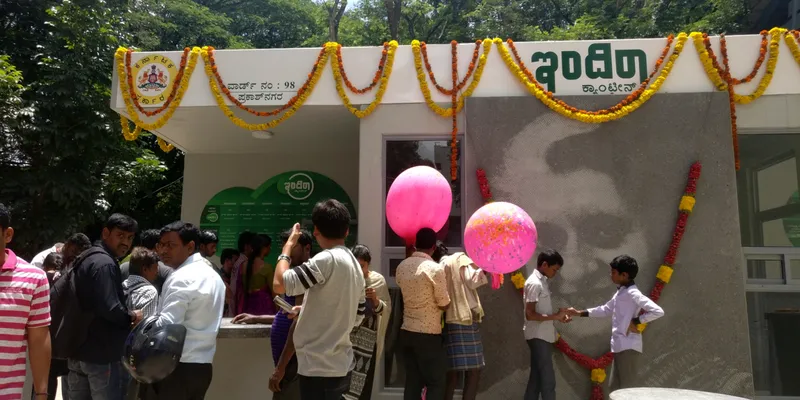
People from all castes, creed, gender and economic classes have descended on this canteen. From a small businessman, a balloon seller and an auto rickshaw driver to schoolchildren, teachers and college students, all shades of Bangaloreans are visible in the canteen premises.
The menu highlights the standard prices for the three meals: Rs 5 for breakfast, and Rs 10 each for lunch and dinner. While the actual cost of three meals works out to Rs 57, the customer pays Rs 25 and the rest is borne by the BBMP.
Locating the canteens is not easy though. The mobile app’s integration with the Google Maps is quite helpful as it shows the nearest five canteens based on your real-time location. However, the app doesn’t tell you whether the canteens are operational or not. This will cease to be an issue once all the canteens are running.
Muralidhar, a manager at a nearby printing press, has just finished his plate of rice and sambhar at the canteen. "The food is good," he says enthusiastically.
Quantity is slightly less, I feel. If they had provided some more, it would have been nice. But for Rs 10, this meal is worth it. People of all economic classes come here. Yes, there are few initial hiccups as is excepted with any initiative, but hopefully, it will improve.
Loving it

Two Class 10 students of MSS High School sit comfortably on a bench in the park, savouring their lunch. “It is delicious and fills my stomach,” says Likith, adding that he is going to tell his friends about the canteen. The boys say they would like to visit the canteen for breakfast every morning. After all, the bissi (hot) idlies cost just Rs 5.
The low cost of food, coupled with the promise of taste and hygiene has managed to spike the citizens’ curiosity. While few of them are unsure of second visits, they recommend that people should try the food at least once.
On his first visit to the canteen, Anil Kumar, an autorickshaw driver, is quite satisfied with the food served in a yellow coloured plate.
I generally eat outside. For the money that is spent here, I feel it is all right. I can come and eat here where it is less crowded. Of course, it isn't like home-cooked food; however, it is 'normal', Anil says.
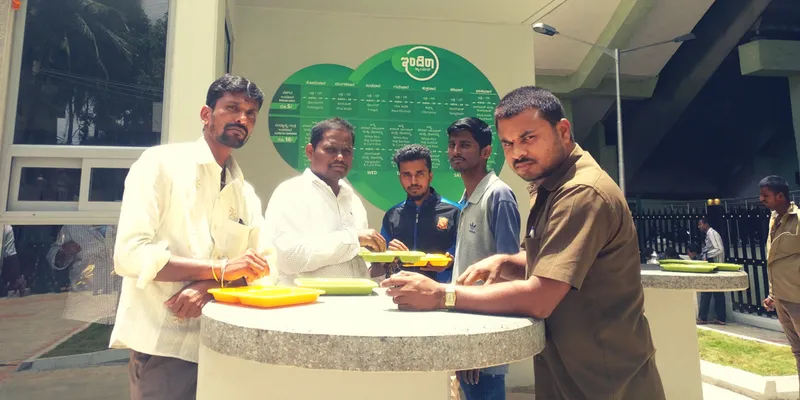
The teachers described the meal as 'cheap and best'. They say “maybe” when you asked them if they will consider a second visit.
The government has gone green in their initiative. These canteens serve food in plastic plates so that they can be washed and reused. Further, the leftover food is segregated and collected in a 'wet waste' bin which is then transferred to a BBMP garbage collecting vehicle for disposal.
Further, these canteens have ample space for interaction among customers and tables are thoughtfully placed. A key highlight of Indira Canteens is the provision of separate toilets for men and women. In comparison, Bengaluru’s Namma Metro provides this facility only in selected stations.
Servings are too small
But there are issues with quantity at these canteens. A common complaint of people is that the quantity is too meagre.
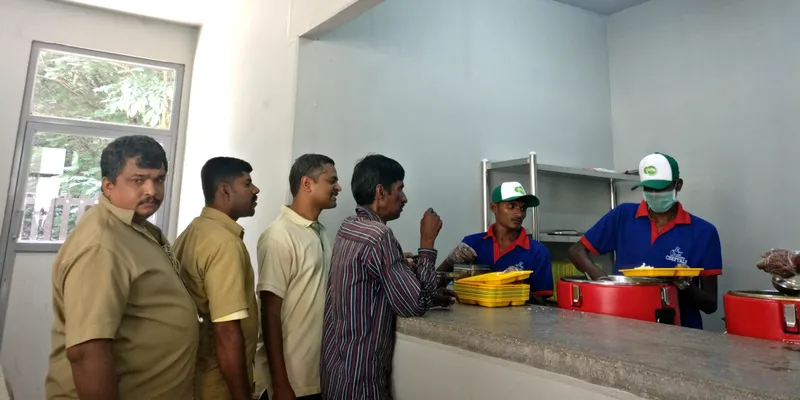
Jayaprakash, for instance, ate lunch on the inaugural day. When he visited the canteen for the second time, he found the portions too small. "The quantity is not sufficient at all. Though there are specifications on the quantity of food to be served, they are cutting back."
Jayaprakash believes the government needs to nurture the initiative.
The chief minister gives a statement that the government is providing meals at subsidised rates. He must have eaten it once and maybe it was good. He and his party members must pay a visit every week or so to know the standard that is being maintained. If they continue to maintain the quality and quantity as done on Day 1, this initiative will grow, he says.
"It isn't the poor people who are visiting, but the rich. Of course, the subsidised rates will help us purchase food for someone begging on the road," he adds after some thought.
Jayaprakash informs that this was his last visit to the canteen.
Bhaskar Raju, too, is critical of the food, saying it is fit for a medical patient. He says: "The food lacks salt and spices. They are serving 200gm as against 300gm. Even the prasad given at temples has more quantity, and here we are paying for the food."

The scheme clearly specifies the quantity of different parts of the meal. Its mandatory to 300gms of rice, 150gms of sambar and 100gms of curd rice (or any other second dish). The serving spoons are used for measurement. The BBMP has deployed a supervisor to ensure that the food arrives on time and the waste is properly disposed. The supervisor must inform the control room when the food arrives as well as the number of tokens sold at the end of every meal.
While the lunch timing was between 12.30 and 2.30 pm, the canteen ran out of food by 1.45pm. A total of 290 people were served. The servings were 150gms for each item.
Read More:
Bengaluru gets a new Rs 30cr emergency response service 'Namma 100'
Narasimhamurthy, a coolie, and his friend were told there was no food when they arrived at the canteen at 1.50pm. They were among several others who were turned away for the same reason. "I had come here at around 8.30-8.35, and the breakfast was over by then. Now it is lunch time, and there is no food again."
There are no proper facilities in Mayor Padmavathi's ward. This is like standing in queue purchasing a ticketing for a Rajkumar movie. You either get it or you don't. If you are launching an initiative, you should either do a good job or not do it at all. They should serve food to all those who come during the scheduled hours, adds Narasimhamurthy.
Nandish, Executive Engineer and Nodal Officer, is part of the team appointed by the BBMP Commissioner to oversee the operation of Indira Canteens. Questioned about the alleged shortage of food at canteens, Nandish says that the first week was an "assessment week" when the food is prepared only for 300 people per meal per canteen. He says the government did not estimate such a tremendous response for the initiative. In the coming weeks, he says, a call would be taken on whether the food availability needs to be increased or decreased depending on the response at each canteen.
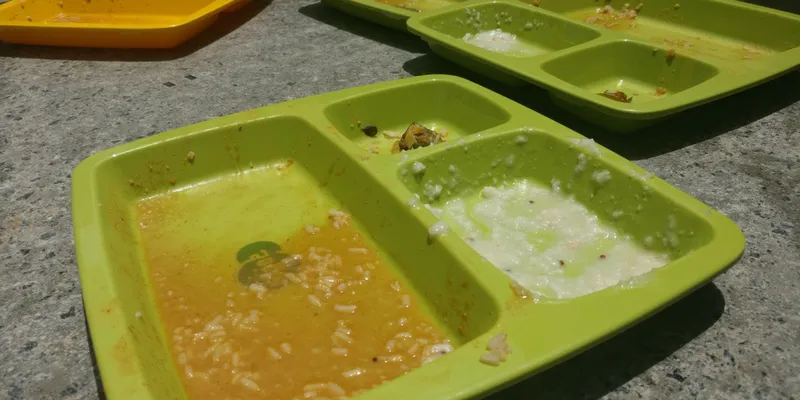
Each canteen is meant to cater to 500 people for every meal. Nandish explains that this is the maximum the centralised kitchen is designed to cater to per canteen.
The economics of Indira Canteens
As per Chief Minister Siddaramaiah’s announcement on 16 August, 101 Indira Canteens were to be functional across Bengaluru from the very first day, and another 97 are to be opened by October 2. However, many of the 101 centres have yet to open.
The BBMP contractor for the canteen in Ward 95, Jayaram K, says that although the canteen was supposed to be thrown open to the public on August 19, it has been delayed and will be inaugurated on August 20 by Congress leader Dinesh Gundu Rao. The canteen is located right next to a bus stop. However, barely few metres away, a storm water drain sits with water pools and foul smell.
Pegged at a budget of Rs 200 crore, as announced in the 2017-18 state budget, the original plan for Indira Canteens mandated the presence of one kitchen per constituency. The food would then be transported across the wards and canteen in that locality in large NilkamalCambro boxes that has temperature locking system. The kitchen contract was disbursed in the form of tenders to various companies, NGOs and hospitality centres.
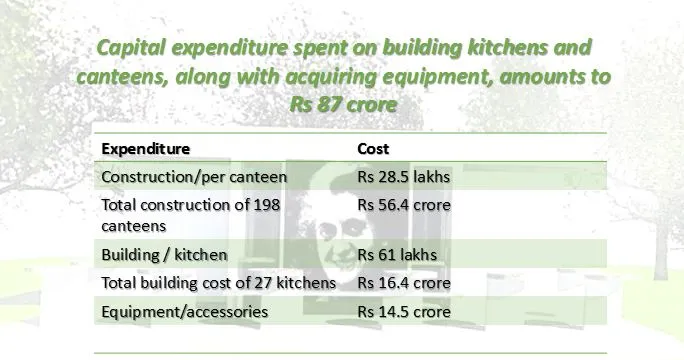
In addition to these one-time costs, the project’s operational cost would be Rs 10 crore per month.
At present, one BBMP-owned centralised kitchen is operational, and another six by the service providers are in finishing stages. By October, there will be 27 centralised kitchens; one in each assembly constituency, informs Nandish.
With regards to complaints about the quality and food safety checks, Nandish informs that a BBMP doctor will be appointed as nodal officer for each kitchen and a health inspector will be appointed for each of 198 wards/canteens soon.
The Indira Canteen initiative seeks to serve the poorest of the poor through the provision of food security, sanitation and hygiene. Yet, like all government schemes the proof of success lies in the small details. The government has to implement the initiative on the ground. As they say in the hospitality sector, the customer is king and the government is a public servant, after all.
Video Credit: Anjali V and Shruti Kedia
Enter the SocialStory Photography contest and show us how people are changing the world! Win prize money worth Rs 1 lakh and more. Click here for details!







